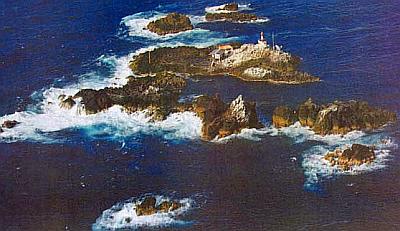Jun 30, 2012, Sao Paulo and Miami The Araucaria DX Group, in conjunction with the TX3A Team, is pleased to announce a DXpedition to St. Peter and St. Paul Rocks, PY0S, under the call sign PT0S. The DXpedition will take place in the late November to mid December, 2012 time frame. The actual dates will depend on weather conditions and will be announced. There has been an official ban on Amateur Radio activities from PY0S. Although the ban, which was created for environmental and safety reasons, remains in place, the Araucaria DX Group was given a special permit by Brazil’s SECIRM (Secretaria da Comissao Interministerial para Os Recursos do Mar), the Brazilian Navy, Ministry of Environment and LABRE to conduct a two week long operation. The operation will have a strong low band focus. There will be a dedicated 160 meter station operating on 160 meters from sunset to sunrise. A second station will be on 80 and 40 meters at night. During the day we will operate two stations on the higher bands -- and 6 meters -- based on conditions. RTTY will also be supported. The DXpedition’s goal is to give this rare and difficult entity to as many amateurs as possible, taking maximum advantage of this unique opportunity. The group will be using newly designed RX antennas and receiving equipment to allow small and QRP stations to work PT0S on all bands, but especially on 80 and 160 meters. For operating procedures and advice on how to maximize your chances of getting into the log. All QSO-s will be loaded onto LoTW within 36 hours of taking place. ADDITIONAL INFORMATION
The Saint Peter and Saint Paul Archipelago (ASPSP) is a group of 15 small islets and rocks in the Atlantic Ocean, lying close to the equator and about 520 nautical miles (990 km) east of the Brazilian city of Natal. The rocks are close to the Intertropical Convergence Zone (ITCZ), are area of constant and severe thunderstorms, resulting in permanently noisy radio conditions, especially on the lower bands. The rocks are located relatively close to both North America and Europe. We hope that the proximity of the rocks to Europe and North America will allow relatively small stations to work this rare entity. We will be operating from the largest rock, called Belmonte. This is a very a difficult place to operate from. Although the Brazilian navy maintains a scientific research station on Belmonte, which is manned year around, we will have to be totally self-reliant and will be unable to use station's facilities. Apart from the location of the research station, there is no flat ground on the rocks. We will be taking a pre-fabricated platform on which we will erect our tent. Due to their strategic importance, the Rocks of St. Peter and St. Paul are treated differently by the Brazilian government to other islands in its territory. The Secretariat of the Interministerial Commission for Sea Resources (SECIRM) manages the archipelago in a manner the maximizes protection of national and environmental interests in the region. The infrastructure of the archipelago is very complex. Researchers take turns constantly on the research station located on Belmonte islet. The conduct research in areas of geology, biology, oceanography, meteorology and other academic and national interest. The difficulties of access in terms of almost 1,000 km distance that separates this small part of the country from the continent, the absence of drinking water, the frequent earthquakes; are just some of the difficulties encountered by the Brazilian government in managing the site. As a consequence of several meetings with the Brazilian authorities, the organizers of the Expedition, represented by the Araucaria Dx Group's Chairman (PY5EG Atilano de Oms), had the opportunity to show the relevance of ham radio activity to the communications community as well how the Dx-Pedition intends to cooperate to meet the requirements of the occupation of the archipelago and demonstrate its compatibility with the ongoing activities. The Brazilian Navy through SECIRM is giving total support to the expedition.
Due to the fact that the archipelago is a very important natural Brazilian reserve, a special permit from Ministry of Environment ( ICMBIOS) has been issued (NR 01-2012).
The expedition has also received a fundamental support from the Brazilian Amateur Radio League LABRE, as well from ANATEL (Agencia Nacional de Telecomunicacoes). A special call has been assigned PT0S.
During all contacts with the Brazilian entities, we emphasized the importance of the work done by radio amateurs and reciprocity that could derive from this understanding. The operation is aimed not only at bringing this rare location to the DX community, but also to demonstrate that Amateur Radio is in fact totally compatible with the scientific and environmentally sensitive nature of the St. Peter and St. Paul Archipelago.
The Araucaria DX Group greatly appreciates the understanding and support of all its friends and Brazilian authorities.
Additional Background:
The archipelago of St Peter and St Paul is a group of small rocky islands and rocky which is situated in the central equatorial Atlantic Ocean, lying 627 km from the archipelago of Fernando de Noronha, 986 km the nearest point on the mainland and 1010 km from Natal, in Rio Grande do Norte. It was declared as part of the Brazilian territory, according to IBGE belonging to the state of Pernambuco, despite being closer to the state of Rio Grande do Norte. In 1998 a scientific station was opened on the island Belmonte, initiating the program Archipelago of Sao Pedro and Sao Paulo (Proarquipelago) administered by the Secretariat of the Interministerial Commission for Sea Resources (SECIRM). The permanent presence of scientists in scientific station is required to prove the livability in the archipelago, which is seen as crucial for its international recognition as the archipelago as Brazilian territory.


